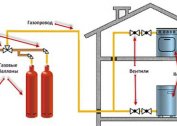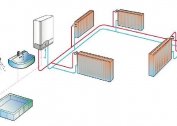A classic oven unevenly distributes heat. One section of the house can remain warm, while in the back room there will be street temperature. The water circuit, which is installed in the furnace, allows you to expand its capabilities. Thanks to the installed radiators, the boiler heats the entire area of the house, giving off maximum heat at minimum cost.
Embedding the boiler in the furnace is not a very time-consuming process, the main thing is to understand how to do it correctly. You will need to create a heat exchanger (most often, this is a simple coil).
It is necessary to arrange the heat exchanger so that it does not interfere with the loading of fuel and its combustion in the furnace. They make a coil of pipes or metal plates (usually use heat-resistant stainless steel).
 The heat exchanger is placed in the combustion tank. Due to the ignition of fuel - the water is heated. After that, the liquid is sent to heating radiators, which transfer heat to the room. Then, the water comes back to repeat the heating cycle.
The heat exchanger is placed in the combustion tank. Due to the ignition of fuel - the water is heated. After that, the liquid is sent to heating radiators, which transfer heat to the room. Then, the water comes back to repeat the heating cycle.
What designs are:
- with natural circulation. Standard version, characterized by complete non-volatility. Water moves due to thermal expansion and increased water pressure. No pumps are required here. The water flow independently rises, and then, under the action of gravity, it returns to the radiators. At the top point, an expansion tank is placed in the open state. This allows you to remove excess air from the pipeline system;
- with forced circulation. In this design, a pump is installed, with the help of which water moves through the pipeline. The pump is powered by electricity. Therefore, such a water boiler cannot function autonomously.
Pros and cons versus conventional ovens
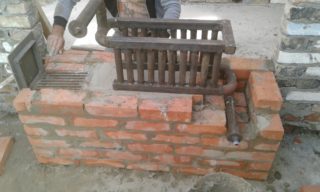 A boiler with a water boiler is a universal solution. The design can be used both for space heating and for hot water supply. In addition, a cooking panel and an oven can be integrated into the oven.
A boiler with a water boiler is a universal solution. The design can be used both for space heating and for hot water supply. In addition, a cooking panel and an oven can be integrated into the oven.
The advantages of a classic stove with a water boiler:
- saving space by reducing the size of the furnace. A conventional oven takes up a lot of space. But when installing a heat exchanger, the size of the fuel tank, and not the furnace itself, is important. This makes it possible to install more compact furnaces;
- uniform distribution of heat throughout the house. With a conventional oven, this effect is difficult to achieve. Most often, the heat is felt only near the structure itself, but not in the far rooms of the room. The installation of heat radiators and a heat exchanger will make it possible to make a small boiler room out of a bulky stove, which will heat the entire home space;
- time saving. The stove does not need to be heated. It is enough to put fuel in the morning and in the evening (in extreme cases - once a day). This is enough to power the structure;
- increase in efficiency. In conventional furnaces, the ratio is 50-60 percent. In furnaces with a heat exchanger, up to 85 percent.
And yet, there are drawbacks to such boilers. Constant compliance with fire safety regulations (as with other heating systems) is required. Before kindling it is necessary to install a fence made of heat-resistant material.
The installation process itself requires certain professional skills. You can install such a furnace on your own, but it is recommended that you seek the advice of specialists. Masonry is a subtle art that cannot be mastered in one day.
When erecting a furnace, laying an additional foundation will be required.
How to design and what to pay attention to
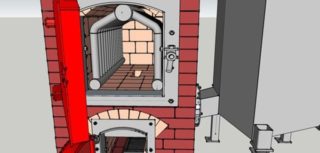 The construction of the furnace begins with the design. First, a heat exchanger is developed and manufactured, then, based on its size, the furnace is laid. The main task is to make the brick boiler as productive as possible. This requires compliance with several conditions:
The construction of the furnace begins with the design. First, a heat exchanger is developed and manufactured, then, based on its size, the furnace is laid. The main task is to make the brick boiler as productive as possible. This requires compliance with several conditions:
- combustion products must leave the furnace with a minimum temperature. The amount of heat given off by the gases inside the furnace determines the design efficiency;
- It is recommended to place the heat exchanger outside the fuel tank, as the firebox is the hottest place in the furnace. Accordingly, the heat exchanger will collect heat. In turn, this will reduce the efficiency of the furnace;
- The water flow in the heat exchanger must be directed so that it flows towards the heat. This will provide a more efficient heating, due to the preservation of temperatures between the media;
For the manufacture of a heat exchanger, it is best to use heat-resistant stainless steel. You can use a cheaper option: corrosion-resistant steel, but this will affect the quality of the structure.
When the location of the furnace is determined and the foundation is laid, you can begin to order the design with the boiler. The arrangement is a plan for installing bricks, which will allow you to determine where should be: blower, fuel tank, cooking panel, chimney, and so on.
You can find a detailed plan on the Internet. Many specialists (and simply skilled stove-makers) post their schemes and drawings for free access.
As an option - installation of a bell chimney with a heat exchanger placed in it, which is made in the form of a register (pipes welded into one large loop).
Such a scheme will allow:
- trap gases from the furnace in the hood;
- ensure uninterrupted combustion in the fuel tank;
- create a natural circulation of heat.
Features of installation and further operation
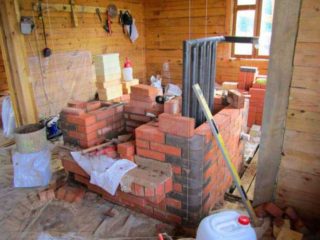 After completing the preparation, proceed with the installation of the furnace, which proceeds as follows:
After completing the preparation, proceed with the installation of the furnace, which proceeds as follows:
- Prepare a mixture of water, clay and sand (ready-made solution can be purchased at the store).
- Seal the foundation with a waterproofing layer. Suitable roofing material or any other protective material.
- Apply a previously prepared (or purchased) solution to the protective layer. Lay out a brick row. Then, following the order, erect the base of the furnace. Install the coil.
- Lay out the compartment for kindling and ash (following the outline).
- Secure the fire door with wire. Then install the stove vault and chimney. Place bricks with rounded corners inside the combustion chamber so that soot does not accumulate there. This may cause a fire.
- Once you have finished making the furnace, proceed with installing the water boiler. Attach the circuit pipes to the heat exchanger by connecting them to the radiators. Install an expansion tank and fill the system with coolant.
Now it remains to carry out finishing work. For the outer layer of the furnace, plaster or tile is used.
The advantage of the furnace is its autonomy. You don’t need to come up and pour new fuel every hour. It is enough once or twice a day: morning and evening. But use the stove with a water circuit carefully. Remember to comply with fire safety regulations.
